| 1 | Many horned adder |
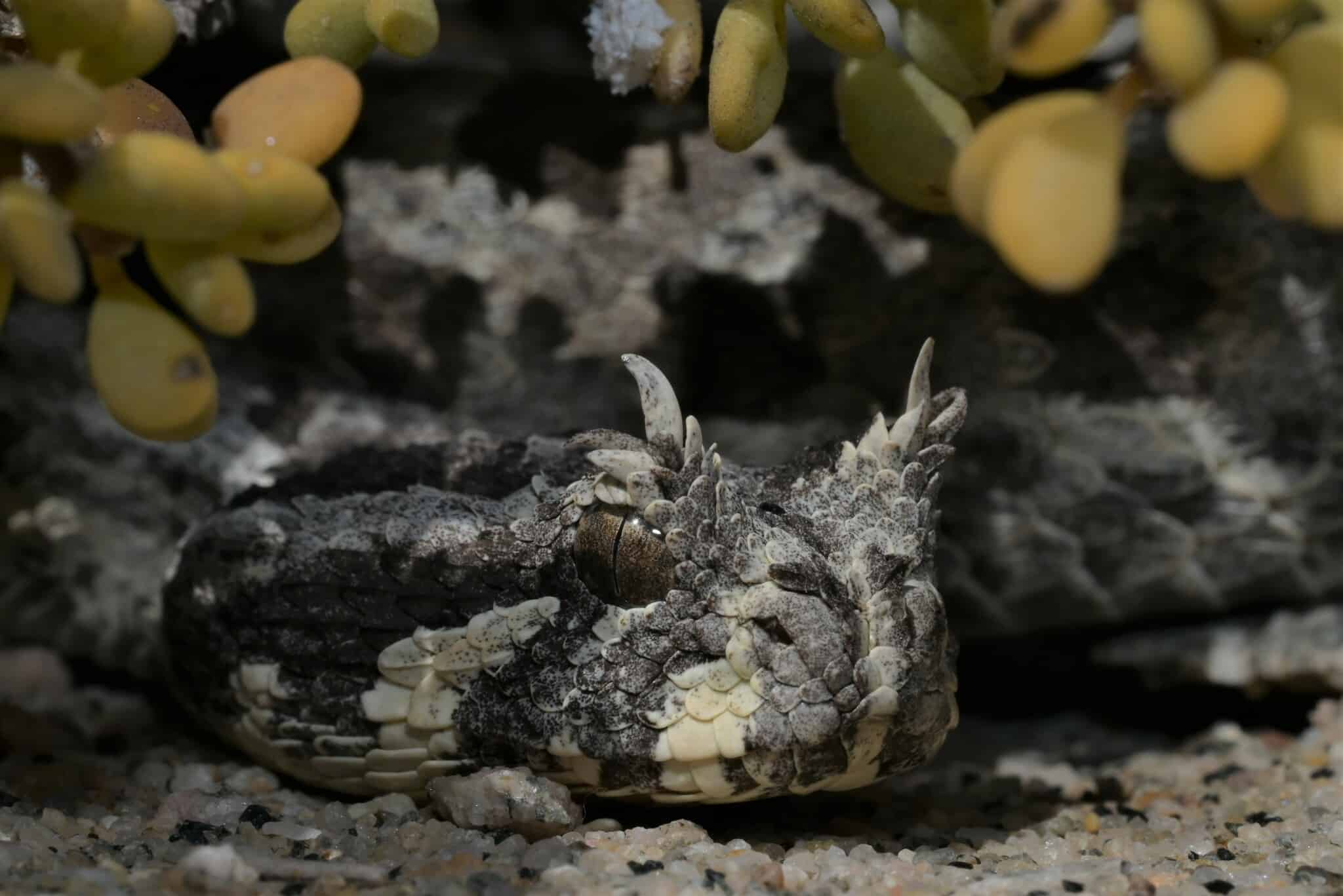
An African species with a horn above each eye, sometimes called the “hornsman”. The many horned viper not only has horns, but horns springing out horns springing out of more horns.
This snake is part of the same Bitis family as puff adders and gaboon adders, but is shorter, reaching a maximum of 75cm, and usually just 30-50cm. They live in just two countries; South Africa (extreme west) and southern Namibia. They stick to rocky plains and gravel flats, where they take shelter in the midst of dark crevices, and their grey scales and jagged horns are perfect for blending in.
Many-horned adders (Bitis cornuta) have no need to pierce people with their horns, as they’re mainly for intimidation purposes. Instead, they have a cytotoxic venom which is reputed to be extremely painful and can cause local necrosis. Luckily, Bitis cornuta venom isn’t severe, and no deaths are known. This species looks far more menacing than a black mamba at first glance, yet the black mamba’s neurotoxic mixture can kill within minutes. Many-horned vipers vary in colour, depending on locality. They range from clay red to stone grey, to beige with dark brown blotches.
| 2 | Saharan horned viper |
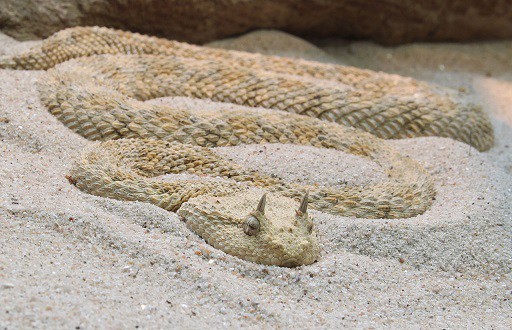
The mascot for horned snakes around the world. This is a dweller of North African sand dunes, and semi arid areas with dry shrubs. They’re found in Tunisia, Libya and Egypt, and measure 40-60cm, with a venom that’s literally heart-squeezing.
Saharan horned vipers (Cerastes cerastes) have particularly bulging eyes, which sit on the side of their head, allowing them to scan the rolling desert dunes in all directions. The savage horns are actually a single enlarged scale, like a mutant tooth that grew way too far. The exact reason this evolved isn’t known, but one theory relates to hunting. This species buries itself in sand dunes in order to ambush gerbils. They spring out and grab the unsuspecting victim, but it’s also thought that their horns act as lures, by poking out from the surface.
This snake looks like a pure being of sand. Their eyes look sandy, and even their tongue has a sandy beige upper half, with a browner base. This horned snake mainly eats rodents, two species being the Greater Egyptian gerbil and Anderson’s gerbil.
| 3 | Fan-Si-Pan horned pitviper |
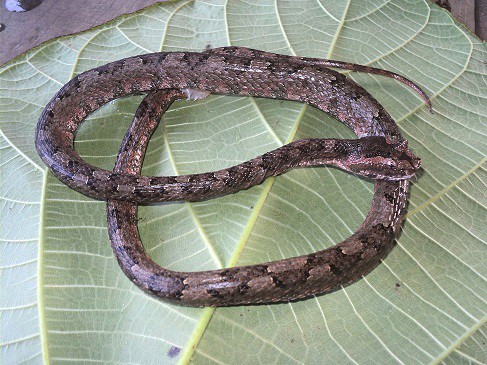
This horned snake lives in Vietnam and southern China, and has a fragmented range, with various disconnected pockets of territory.
Protobothrops cornutus are one of the thinner vipers worldwide, and vary in appearance. Some are stony grey, while others have reddish tinges. But a consistent feature is a pair of sharp horns, whose purpose is completely unknown, but definitely adds to the fear factor.
This snake is almost fully nocturnal, and likes karst mountainous regions, where they hide in limestone outcrops. They lurk out of sight all day, waiting patiently until it’s their time. When the sun sets, Protobothrops cornutus pokes its head out and begins the night’s hunting. Protobothrops cornutus can appear on the edge of mountain trails, sometimes climbing trees to 0.5-1 metres high. They particularly like areas near cool, running water.
Fan-Si-Pan horned pitvipers have a defensive temperament, react quickly to movements, and have a rapid and accurate strike. Luckily, their venom isn’t especially severe. Protobothrops cornutus also has a pale tongue, and an extremely triangular head when viewed from a bird’s eye.
| 4 | Rhinoceros ratsnake |
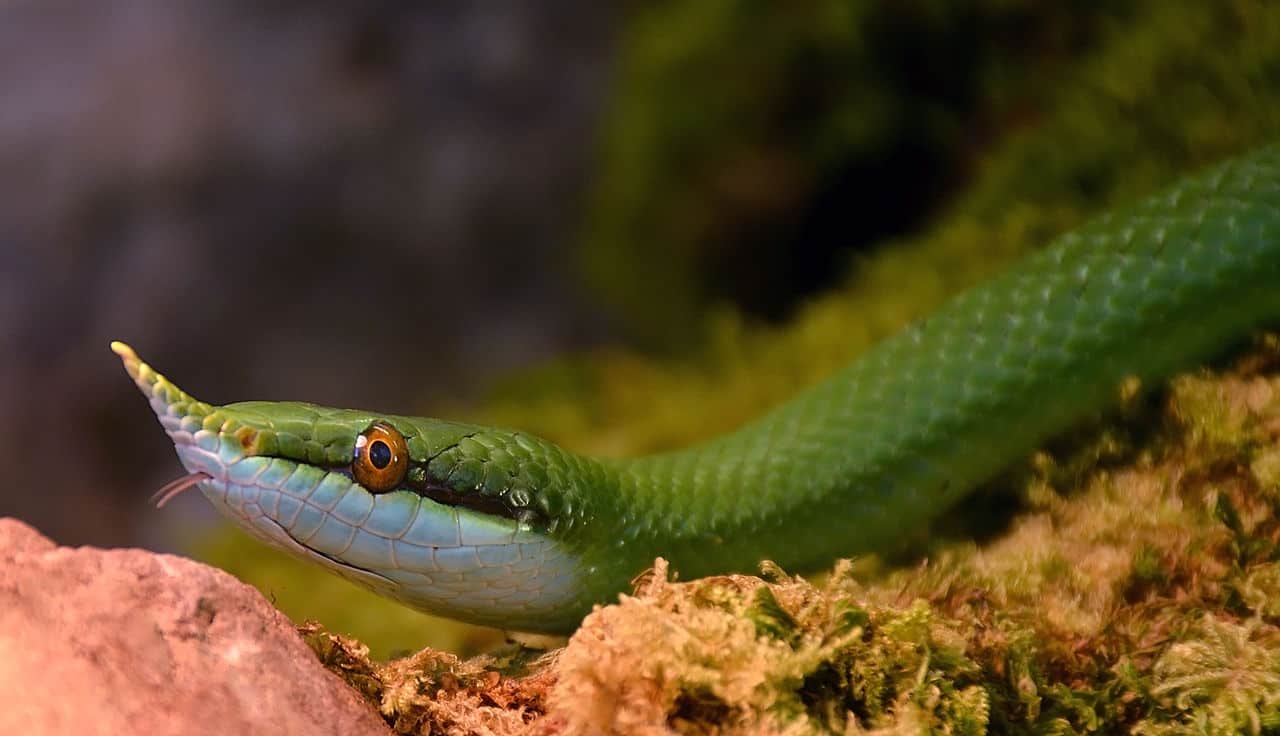
This is a close relative of the red-green ratsnake, famous for its blue tongue. Closer inspection reveals a not so subtle difference: a huge rhinoceros style horn sprouting from its face. Rhinocerous ratsnakes live in riverside forests and mountainous areas, far from busy towns. They range from southern China to Vietnam, and are a non-venomous snake which poses no threat to humans, except maybe with a poke.
This is the only non-viper on our list, proving that other snakes can sprout a horn too if they concentrate hard enough. As well as the gigantic horn, they’re also recognisable by a black stripe surrounding the eye. The purpose of the horn is still a mystery of science. Rhinocerous ratsnakes were first discovered in 1897, when 6 were spotted in Vietnam’s gulf of Tonkin. It’s fair to assume that the scientists knew it was a new species right away.
As of 2021, this horned snake is now two species. A population was discovered in the mountains of Hainan island, China, which lacked the black stripe spreading backwards from the eye. This was dubbed Gonyosoma hainanese. These are the only two Gonyosoma family members (with 8 in total) to have the rhinocerous horn.
| 5 | Persian horned viper |
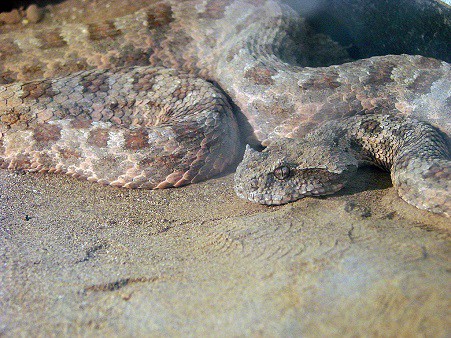
A snake of arid habitats, with a maximum recorded length of 108cm. Persian horned vipers inhabit Iran, Pakistan, Afghanistan and northern Oman. They belong to the Pseucerastes family also containing the disturbing spider tailed viper.
With their vertical pupils and keeled scales, this snake would already be intimidating, but a horn above each eye seals the deal. With Pseudocerastes persicus, the horns consist of multiple scales built in top of each other, while with the Saharan horned viper, they’re just a single super enlarged scale.
This snake is venomous, but usually survivable. A 33 year old man was bitten in Kerman province, southeastern Iran, and suffered only local pain and swelling. The worst bites can cause haemorrhaging in the classic viper style.
Persian horned vipers likes to lurk in shaded rock formations and below boulder piles, to avoid the burning sun. Mammal burrows are another favourite hangout. They like arid environments, so if you get lucky, the sun might strike at the right angle and create a nightmare silhouette, with a snake’s head and a pair of noticeable horns sticking up as they gaze down from a hill.
| 6 | Mexican horned pitviper |
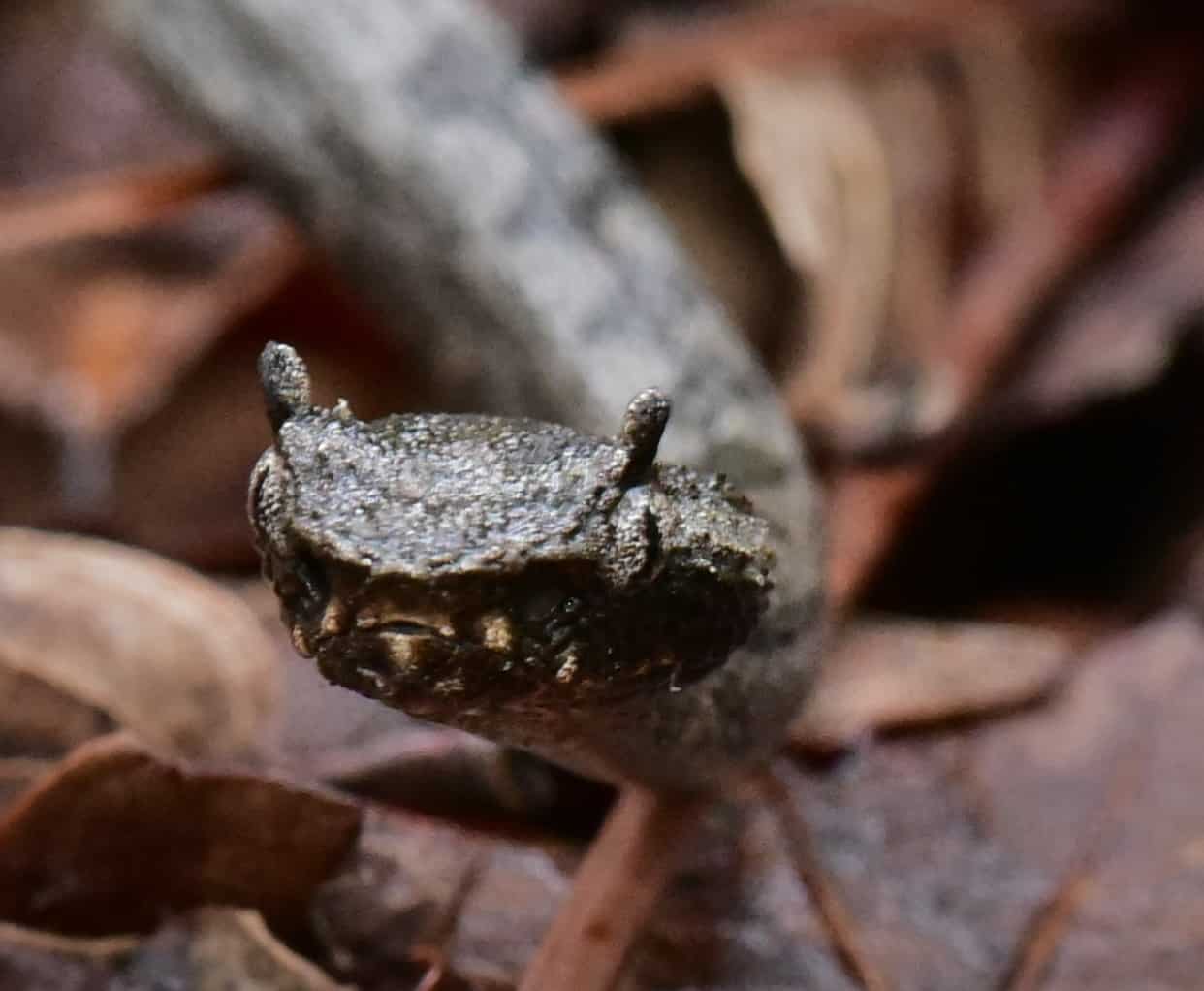
A species of mountainous southern Mexico, particularly in Oaxaca region. Mexican horned vipers (Ophryacus undulatus) live at altitudes of 1800-2800 metres, in lush pine-oak forests and cloud forest. You won’t find this snake terrorising wheat farmers, as they prefer scenic spots with crisp air.
Mexican horned vipers are a hard snake to find, as their camouflage is excellent. Their scales are a complex mixture of grey and green, which blends perfectly in to a mossy boulder or forest floor. But if you catch one out of the corner of your eye, then there’s no doubt what you’ve found, as their horns are a dead giveaway. Ophryacus undulatus have a horn above each eye, which is more rounded compared with a Saharan horned viper. This is a venomous snake, yet not particularly deadly. A 2019 study found its venom to be milder than its cousin, the broad-horned pitviper.
Ophryacus undulatus also has a sharply triangular head, and its eyes are rich with detail. They mainly stick to the ground, climbing low branches and bushes on occasion. This species is found solely in southern Mexico, with no crossover into Guatemala next door.
| 7 | Butterfly viper |
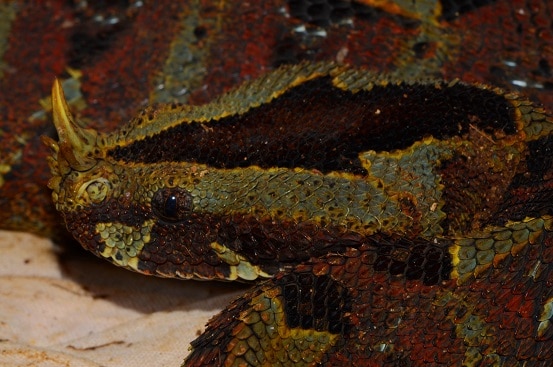
Known as the butterfly viper for its striking colours, but Bitis nasicornis also possesses a collection of deadly horns. Rather than two neat horns above each eye, these sprout from the same spot and twist at unnatural angles.
Butterfly vipers inhabit central Africa, from Kenya to Nigeria to Ghana, and reach a record of 120cm. This is a jagged snake in every way. Their scales are so sharply keeled that they sometimes slice open snake handlers’ fingers. Their sharpness is easy to see from a photograph, and the last piece of the puzzle is their horns. Once again, nobody knows why they evolved. It may simply be to intimidate predators, or there may be a subtler hunting angle. They might be weapons which they can swing upwards if a greedy eagle descends (though this is pure speculation).
Butterfly vipers have an extremely loud hiss, almost like a shriek. A study analysed their diet in Nigeria in 2003 and found mainly mammals, with a side helping of amphibians. This snake tends to lurk in the undergrowth like a dormant tank, and spring to life when rodents pass.
| 8 | Nose-horned viper |
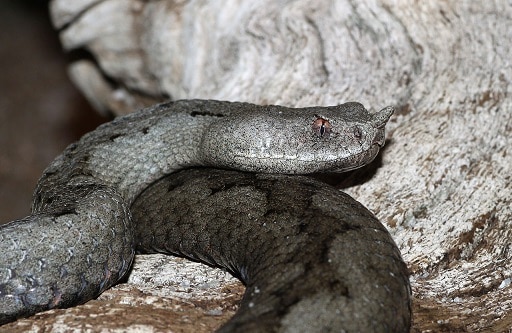
This 50-70cm snake gained its name because the rhino-style horn is the first thing you notice about it. The second is its stony grey scales, designed to blend into rock fields, allowing them to disappear totally, only reappearing when hikers step on them. Vipera ammodytes lives in Greece, Albania, Macedonia, Slovenia, and other southeast European countries.
Its horn consists of not one scale, but 7 to 19 scales on top of each other. Touch the horn, and your finger won’t start bleeding instantly, or shrivel up and drop off, as the horn is actually flexible and soft. Many of our horned snakes actually have a milder venom, but not Vipera ammodytes. It’s the deadliest viper in Europe, and is capable of killing adults, with two soldiers dying in Croatia in the 1990s. The venom contains a mixture of neurotoxins and hemotoxins, and is specialised against mammals.
Vipera ammodytes horns vary wildly in angle. In some, like above, they point diagonally forward at 45 degrees. In others, they jut upwards vertically. In this picture, a Vipera ammodytes even has a backward curving horn.
| 9 | Arabian horned viper |
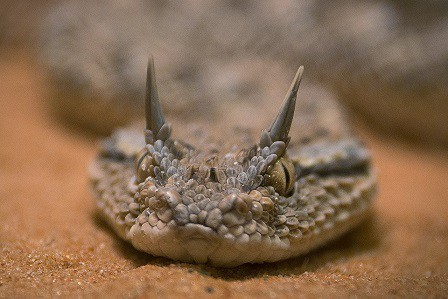
The easterly cousin of the Saharan horned viper. This version inhabits the entire Arabian peninsula, except for a small position of central Saudi Arabia, where the land is so scorched that even they can’t cope. Cerastes gasperatti inhabits Saudi Arabia, Oman, UAE and Yemen. They live a similar lifestyle, lurking in soft sands interspersed with the arid shrubs, waiting for rodents to come their way.
This species measures 30-60cm, with an absolute maximum of 85cm. Not every member of this species has horns. About 50% have flat heads, but when the horns appear, they’re hard to miss. Cerastes gasperettii could probably poke you with their horn if they realised what a great weapon they have, but rely on venom instead. This consists primarily of metalloproteinases (SVMPs) and phospholipase A2s (PLA2s). Their venom targets internal organs like the kidneys, and causes severe drops in antioxidants like glutathione and superoxide dismutase.
Originally, this was a mere subspecies of the Saharan horned viper, until 1988 when it was split. One of the main differences is that the black diagonal line behind the eye is thinner and significantly longer.
| 10 | Rainforest hognose pitviper |
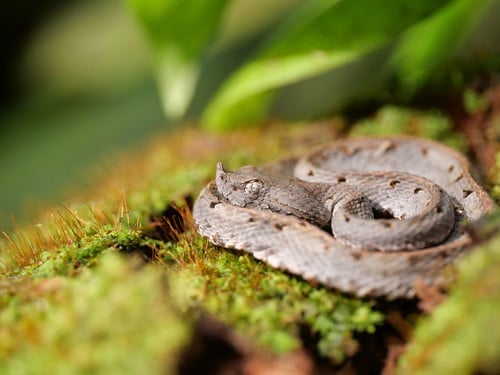
A resident of central America, including Belize, Honduras and Guatemala. This is another rhinoceros stylist, with a large protruding horn above its nose. This is similar to the hognose snake of the US, yet significantly more protruding. Rainforest hognosed pitvipers measure 60cm and lurk on forests floors, blending in almost completely. This an exclusive forest dweller, and it’s extremely rare for them to slither through open grassland.
The rainforest hognose pitviper has an LD50 score of 4.6mg, versus a black mamba’s 0.05mg. This horned creature doesn’t have the worst venom in the world, but is highly targeted against blood clotting. This 2022 study found that Porthidium nasutum venom disables multiple clotting enzymes: Factor IXa, factor Xa and prothrombinase.
These each have multiple roles. Factor Xa is the enzyme which finally cleaves prothrombin to create thrombin, the backbone of blood clots. Factor X is the raw material for factor Xa, and this conversion is facilitated by factor IXa. A rhino horn is not the only weapon of this central American snake.

What amazing animals snakes are. Each snake has it’s own set of skills, venom and ways to kill anyone without quilt.